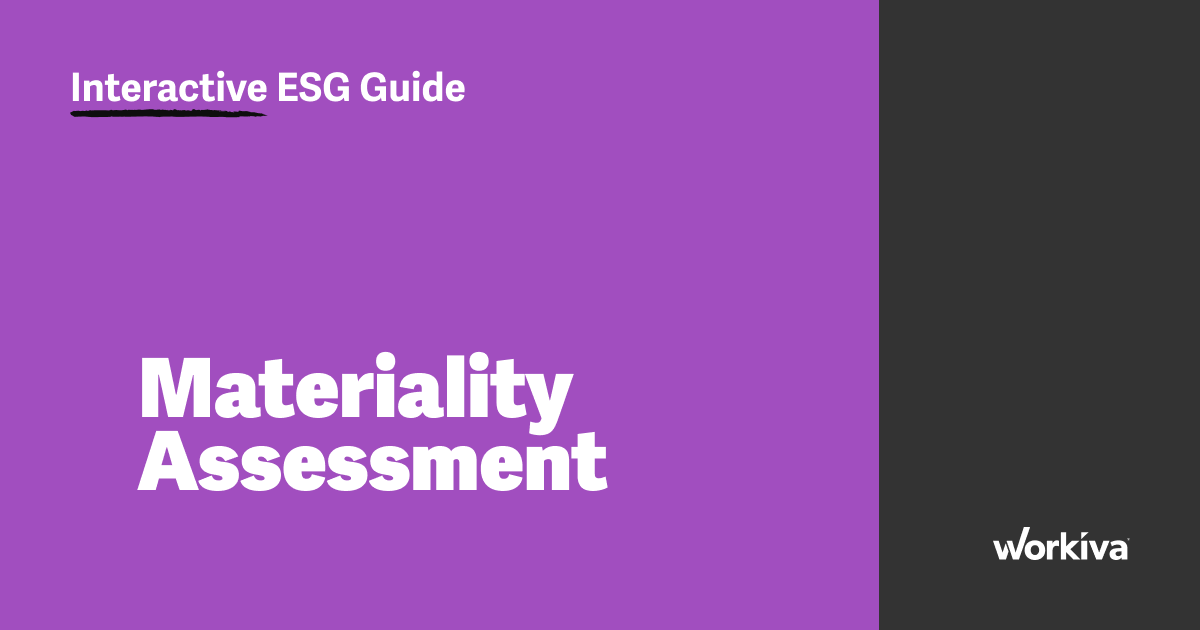Navigating ESG Expectations: 4 Takeaways From Reuters' Sustainable Finance & Reporting Europe 2021
Originally published on Workiva
The drumbeat of ESG-related news is gaining momentum. The recent announcement of the International Sustainability Standards Board (ISSB) is the latest accelerant in a long line of measures aimed at improving ESG reporting. More news is good news: the move towards standardization, comparability, and greater trust will benefit businesses, their investors, and the wider global community alike.
However, it’s also turning up the pressure dial on organizations. They know that regulators, standards boards, and investors are increasing their expectations. They also know that change is coming, and they need to be prepared for it. But, without glass-like clarity on what these expectations and changes are, it’s difficult to make decisions that make the most sense for their business and its stakeholders.
All the noise around ESG is rising to a crescendo in anticipation of its next movement. Among the opacity, moments of clarity reassure businesses and enable them to act. Reuters Sustainable Finance & Reporting Europe 2021, with its focus on providing transparency and enabling action, was one such moment.
Andie Wood, Workiva’s VP of Regulatory Strategy, spoke at the event with the head of ESG at one of Europe’s largest investor firms and a leader in ESG corporate reporting. Together, they discussed the shift towards greater scrutiny, comparability, and navigating the complexity of stakeholder expectations, and offered advice to help organizations pave their own path forward. Here are four main takeaways from the session:
1. Find long-term solutions for immediate needs
There is no such thing as an “easy win” with ESG reporting. While there are signs that some elements of the reporting process will be eased (for example, by providing consistent global standards, the ISSB will significantly reduce cross-framework mapping), the scale of the task is still massive. This is why it’s important to keep the big picture in mind at all times.
During the conversation, Andie warned about focusing on fixing isolated problems within the reporting process. “There's very much a temptation to look for a solution to pick up the first painful thing that's really standing out. One of the issues with that is it doesn't think about the whole process. And it doesn’t necessarily result in the company having a more agile, longer-term solution. I think there is still a lot of change to come.”
Further change is all but inevitable. Organizations know that they need to think beyond existing and proposed ESG mandates. They need technology that can enable them to embed trust and help them to future-proof their environment.
2. Make ESG data fully accessible
A lot of effort goes into gathering an organization’s ESG data to tell its story, which needs to be easily accessible. Although it looks like the Corporate Sustainability Reporting Directive (CSRD) will enforce the use of Inline XBRL® for sustainability data—which should make information contained within reports machine-readable and more easily discoverable—the panel’s recommendation is to not leave everything buried in a PDF.
Investors use AI to scrape websites for ESG data to inform their ongoing strategies. If this data isn’t visible, or if it can’t be scraped from a webpage, then it’s easy for a company’s ESG efforts to either be unnoticed or, worse, negated. Share your results loud and proud—put them on your website.
3. Foster an agile environment
Creating an ESG report is undeniably complex, and internal and external stakeholders’ seemingly amorphous expectations add to this complexity. An investor at the event explained how his firm will require every company in its portfolio—including small and unlisted companies otherwise unaffected by some mandates—to report on their scope 1, 2, and 3 carbon emissions. Other investors may make similar, or altogether different, demands.
From the perspective of someone working on the report, it’s critical to maintain a dialogue with key investors. One panel member shared how his company takes inspiration from all the different reporting frameworks, including those from the Sustainability Accounting Standards Board (SASB) and the Global Reporting Initiative (GRI), and marries it to their robust materiality process. Having this structure in place helps to steer the conversation with investors and ensures that their perspectives are understood.
This approach works for one company—other firms will know what they need to build stronger relationships with investors and meet their demands while maintaining compliance with regulations and standards. Whatever the approach, it needs to be underpinned by agility.
Andie expanded on the topic during the event: “Organizations need a certain amount of agility to be able to pick through the frameworks rather than just think, ‘you go fill in all of this and then miraculously, you will be comparable’...because we know that just doesn't work. It doesn't produce the right material data.
“I think it is going to be really key—regarding both the standards and any tools that companies use—to maintain their flexibility because otherwise companies can't differentiate themselves. They can't tell that story. They can't explain how they are a leader in their sector. Someone from the outside can't look at them and work out what it is about the company that makes them that extra bit special.”
4. Focus on developing strong materiality assessment practices
Because of the ever-evolving nature of the ESG reporting, it’s becoming more difficult to conduct materiality assessments. The predictability of when to conduct these assessments has continually diminishing returns. It’s no longer possible to wait until a specific point of the year to assess what’s material to stakeholders—this insight needs to be tapped into more regularly to keep up with the rapid pace of change and maintain relevance.
Developing a new perspective and approach to materiality assessments, and the processes that surround them, is understandably difficult. But, for many, doing so would prevent a lot of pain. Andie explained, “Once companies have got themselves in a situation where they're comfortable—maybe they’ve spent a lot of time building up a materiality matrix and have identified the key material areas that they need to worry about internally and externally—that there's a bit of a reluctance to have to want to adjust or change that. They’ve done a lot of work to get that stable. Changing it has a lot of downstream effects. It affects the data that needs collecting. It affects which information makes it into internal reports versus external reports.
“But if that downstream process after the materiality judgments have been made isn't robust, then it can leave companies a little bit scared to work on things upstream. Equally, they may not be able to make decisions as freely as they might otherwise want to.”
We’ve put together a guide to establishing robust materiality assessment practices. Check it out here.
XBRL™ and Inline XBRL® are trademarks of XBRL International, Inc. All rights reserved. The XBRL™/® standards are open and freely licensed by way of the XBRL International License Agreement. Our use of these trademarks is permitted by XBRL International in accordance with the XBRL International Trademark Policy.



